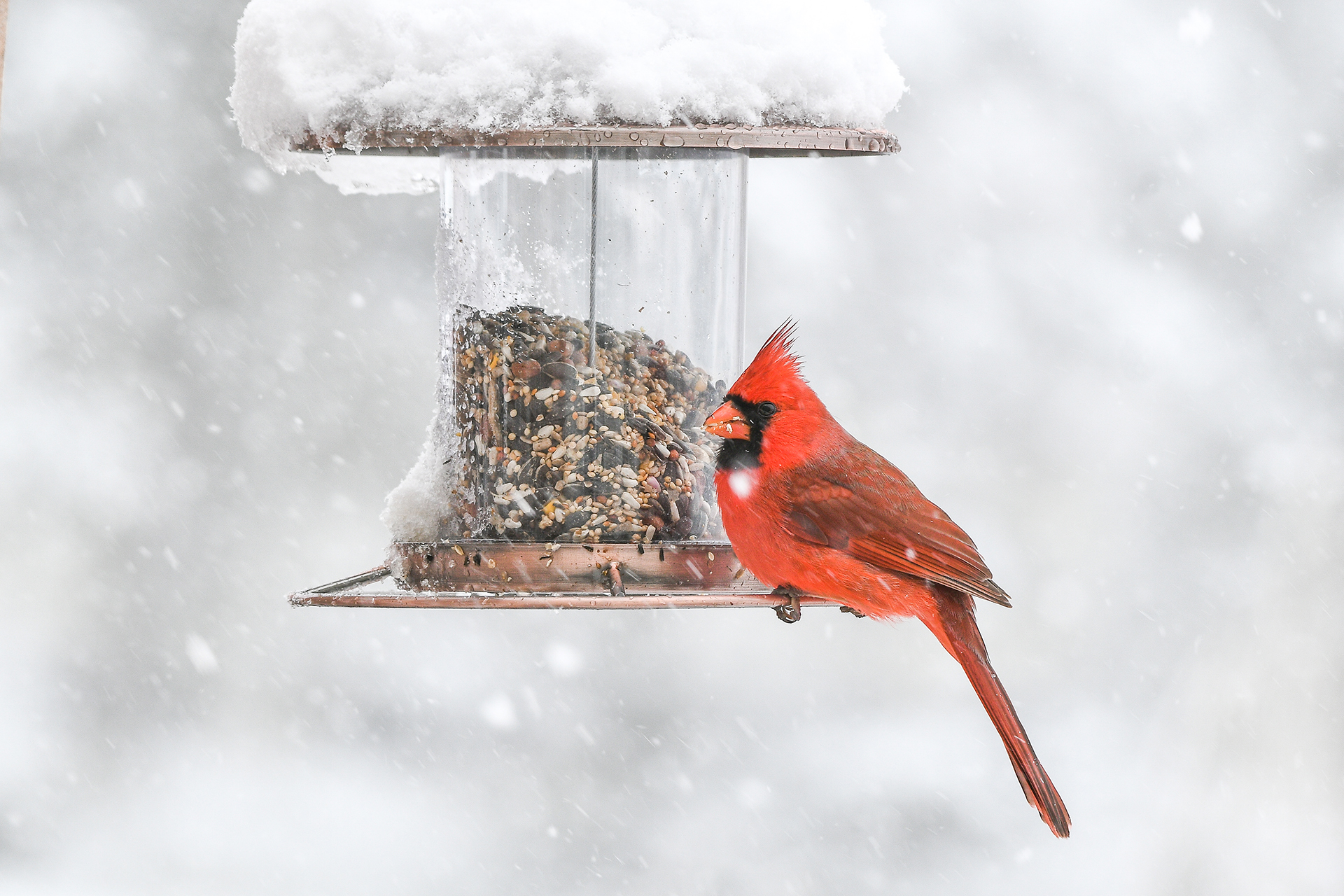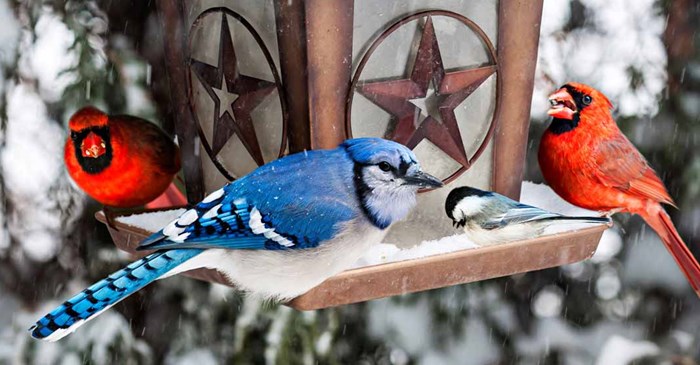During the summer months, the sight of birds flocking to feeders is not as common as during the winter season. This can be attributed to the abundance of natural food sources available in the warmer months. In fact, some bird species that primarily feed on seeds in winter, switch their diet to insects during summer in order to provide nourishment to their young ones. However, backyard feeders still attract a variety of birds, including those that migrate north for the summer and year-round resident birds. Among the most widespread visitors to feeders in the US during summer are the Mourning Dove, Song Sparrow, American Goldfinch, House Finch, Downy Woodpecker, House Sparrow, Northern Flicker, and Chipping Sparrow. Additionally, other common species such as the Northern Cardinal, Blue Jay, Carolina Chickadee, Indigo Bunting, Red-bellied Woodpecker, and Tufted Titmouse can also be spotted at feeders. Each of these birds has its own unique preferences when it comes to food and feeder types, making the experience of observing and attracting them all the more intriguing. This article provides a comprehensive overview of each bird species mentioned, including their preferred foods and feeders, as well as their summer ranges.
Birds at Feeders in Summer: A Comparison to Winter
Summer is a season of vibrant blooms, warm weather, and the joyous melodies of birdsong. As nature flourishes around us, bird enthusiasts eagerly set up their feeders in hopes of attracting a variety of feathered friends. However, they may notice that the number and types of birds visiting their feeders in the summer differ from those in the winter. In this article, we will explore the factors that affect bird populations at feeders, discuss the most widespread and common bird species in the summer, delve into their food preferences and feeder types, and consider regional variations in bird species at feeders.
1. Factors Affecting Bird Population at Feeders
1.1 Availability of Natural Foods
One of the primary reasons for the decrease in bird populations at feeders during the summer is the abundance of natural food sources. With the arrival of the summer season, trees and shrubs burst into foliage, producing an abundance of fruits, seeds, and insects that birds can readily feast upon. With their dietary needs fulfilled by nature itself, birds have less incentive to visit feeders.
1.2 Feeding Insects to Young
Another factor influencing bird populations at feeders is the shift in feeding habits during the breeding season. Many birds that rely on seeds during the winter make a significant change in diet during the summer by feeding insects to their young. Insects provide essential nutrients and proteins necessary for the growth and development of nestlings. Therefore, these birds devote their time and energy to foraging for insects rather than visiting feeders.
1.3 Migration Patterns
During the summer, some bird species embark on long journeys, traveling from their wintering grounds to their breeding grounds in the northern hemisphere. These migratory birds, such as the Swainson’s Thrush or the Ruby-throated Hummingbird, may visit backyard feeders along their migratory routes, but their stay at any particular feeder is often brief as they continue their journey in search of suitable nesting sites.
1.4 Year-Round Residents
While the number of birds at feeders may decrease in the summer compared to the winter, there are still numerous year-round resident bird species that frequent feeders. These resident birds, having established territories, continue to rely on feeders as a consistent food source throughout the year.

2. Most Widespread Bird Species in Summer
Although there may be fewer birds at feeders in the summer, several species remain steadfast in their presence. Let’s take a closer look at some of the most widespread bird species that grace our feeders during the warm summer months:
2.1 Mourning Dove
The Mourning Dove, known for its gentle cooing calls, is a common sight at feeders in the summer. These graceful birds prefer ground and platform feeders where they can dine on seeds scattered on the surface. Their diets primarily consist of seeds, making them frequent visitors to feeders stocked with sunflower seeds and millet.
2.2 Song Sparrow
The melodious Song Sparrow is a delightful visitor to feeders during the summer. These small, brownish birds are often found hopping around mixed seed feeders, eagerly feasting on a variety of seeds and occasionally indulging in small insects. Their vibrant songs can be heard throughout the day, adding joy to any backyard.
2.3 American Goldfinch
One cannot overlook the vibrant beauty of the American Goldfinch, resplendent in its bright yellow plumage during the summer months. These finches have a particular fondness for thistle feeders, where they can be observed delicately plucking tiny, nutritious seeds. As the summer progresses, their plumage gradually changes to a more subdued olive color as they prepare for the winter ahead.
2.4 House Finch
House Finches bring a splash of red to our feeders, sporting reddish plumage on their heads and chests. These finches are adept hopper feeder visitors, enjoying a variety of seeds such as sunflower and safflower seeds. Their pleasant songs and vibrant colors make them a favorite among bird enthusiasts.
2.5 Downy Woodpecker
The Downy Woodpecker, the smallest woodpecker in North America, is a year-round feeder visitor that adds an element of excitement to any backyard. With their sharp beaks, they readily cling to suet feeders, extracting the high-energy fat-rich suet to fuel their active lifestyles. Their distinct black and white plumage, coupled with their rhythmic tapping, is a joy to behold.
2.6 House Sparrow
The House Sparrow, ubiquitous in urban and suburban areas, is a familiar face at feeders throughout the year. These adaptable sparrows are frequent visitors to tube feeders, where they consume a variety of seeds. While some may view them as common, their energetic chirping and lively antics bring life to our gardens.
2.7 Northern Flicker
Known for its unique combination of plumage, the Northern Flicker is a summer visitor to feeders, often observed scavenging for insects on the ground. These large woodpeckers also appreciate the occasional suet offering, tapping into the energy-rich treat. Their distinctive calls and distinctive barred plumage make them a standout among their avian peers.
2.8 Chipping Sparrow
The Chipping Sparrow, with its rusty crown and black eye stripe, is a charming visitor to mixed seed feeders. These small yet lively sparrows prefer to forage on the ground for seeds but are known to frequent feeders, particularly during the nesting season. Their pleasant trilling songs add to the symphony of nature in the summer.

3. Other Common Bird Species in Summer
In addition to the most widespread species mentioned above, there are several other bird species that make appearances at feeders during the summer. These include:
3.1 Northern Cardinal
One cannot overlook the striking beauty of the Northern Cardinal, with its vibrant red plumage and distinctive crest. Cardinals are often seen perched on tray feeders, indulging in sunflower seeds and safflower seeds. Their melodious songs and colorful presence bring joy to any backyard.
3.2 Blue Jay
The Blue Jay, with its brilliant blue feathers and crested head, is a bold and charismatic visitor to feeders. These intelligent birds prefer hopper and platform feeders where they can enjoy a variety of treats, including peanuts, sunflower seeds, and suet. Their raucous calls and acrobatic antics never fail to captivate the attention of onlookers.
3.3 Carolina Chickadee
The Carolina Chickadee, a small bird with a black cap and bib, is a lively presence at mixed seed feeders. These acrobatic birds are known for their agility as they flit from branch to feeder, partaking in sunflower seeds, peanuts, and suet. Their cheerful calls and playful nature make them a delight to observe.
3.4 Indigo Bunting
The dazzling Indigo Bunting, with its vibrant blue plumage, is a feast for the eyes during the summer months. These strikingly colored birds prefer thistle feeders, where they can savor thistle seeds and other small seeds. Their ethereal songs and brilliant hues are a testament to the beauty of nature.
3.5 Red-bellied Woodpecker
While the name may suggest a predominantly red belly, the Red-bellied Woodpecker exhibits its red hues primarily on its head and nape. These woodpeckers are fond visitors of suet feeders, where they extract insects and relish in the rich suet. Their unique calls and bold patterns make them a fascinating addition to any feeder.
3.6 Tufted Titmouse
The Tufted Titmouse, with its crested head and contrasting gray and white plumage, is a charming visitor to platform and tray feeders. These agile birds enjoy feasting on sunflower seeds, peanuts, and suet. Their soft, whistled songs and lively personalities add to the symphony of bird activity in the summer.
Stay tuned for Part 2 of the article, where we will explore the food preferences and feeder types for each of these bird species, discuss regional variations in bird species at feeders, and provide identification overviews, summer ranges, and preferred foods and feeders for each species.

Leave a Reply